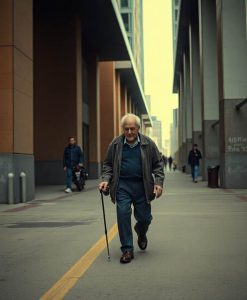Walking isn’t merely a physical action—it’s a profound expression of human potential. As a bioethicist who has studied aging and human mobility, I recognize how seemingly small interventions can unlock remarkable trajectories of wellness. This research illuminates a wonderfully accessible pathway for seniors to maintain strength and autonomy.
Our bodies are adaptive systems, constantly responding to subtle signals and challenges. When older adults incrementally increase their walking pace, they’re engaging in a form of gentle self-optimization. These intentional shifts trigger physiological adaptations that can significantly enhance mobility, balance, and overall functional capacity.
The beauty of this research lies in its fundamental message: aging need not be a process of diminishment, but can instead be a continuous journey of adaptation and resilience. By understanding how small, deliberate changes in movement can support physical and cognitive health, we empower seniors to write their own narrative of aging—one step at a time.
How a Small Step Forward Can Help Seniors Stay Strong and Independent
In the quiet rhythm of our daily lives, walking often becomes a silent metronome,an act so familiar it sometimes slips into the background of our consciousness. Yet, for seniors, that simple act of putting one foot in front of the other can be a powerful dance of resilience, a metaphorical bridge connecting health and independence. When older adults decide to walk just a little faster,adding a touch more pep to their stride,they are not merely increasing their pace; they are planting seeds of vitality that can blossom into lasting strength.
Think of each step as a brushstroke on the canvas of aging,small, deliberate movements that, over time, create a masterpiece of well-being. Recent research underscores that even a modest increase in walking cadence can lead to meaningful improvements in physical function among seniors. It’s as if the body responds to that gentle nudge forward, whispering, “Yes, I can keep moving. I can stay steady on my feet.”
### The Power of a Slight Increase in Walking Speed for Elderly Health
The idea that a tiny shift in walking speed can influence the course of aging is both inspiring and accessible. For many seniors, the notion of tackling rigorous exercise routines can feel daunting. But a simple goal,walking just a little faster,can be woven into daily life like a gentle melody. This isn’t about running marathons or pushing past comfort; it’s about harnessing the natural rhythm of movement to foster strength and independence.
When older adults intentionally elevate their walking cadence, they engage muscles, bones, and joints more actively. These small, purposeful increases in pace act as a kind of gentle catalyst,stimulating physical function without overwhelming the body. Over days and weeks, this can translate into better balance, enhanced mobility, and a reduced risk of frailty,a condition that often shadows the later years with its weight of vulnerability.
Imagine the difference between a leisurely stroll and a purposeful walk—both are valuable, but the latter infuses each step with a little more life, a touch more momentum. The body, like a finely tuned instrument, responds to this subtle adjustment, tuning itself for sustained resilience.
### How Can Seniors Safely Increase Their Walking Cadence?
Encouraging seniors to walk a little faster isn’t about forcing change but gently guiding the body toward a rhythm that feels both achievable and beneficial. Here are some mindful strategies to unlock this potential:
–
Set small, attainable goals
: Aim for a slight increase,perhaps a few extra steps per minute,rather than a dramatic change. This keeps the process gentle and sustainable.
–Focus on posture and stride
: Standing tall and engaging core muscles can naturally encourage a brisker pace without strain.
–Use cues or reminders
: Listening to music with a steady beat or counting steps can help establish a new, invigorated rhythm.
–Prioritize safety
: Selecting even, even surfaces and wearing supportive footwear ensures that the boost in speed fosters confidence, not risk.
This approach turns walking from a routine into a deliberate act of self-care,each step a small investment in future independence.
### Why Small Changes Make a Big Difference in Aging Gracefully
The beauty of this discovery lies in its simplicity. Many seniors may feel overwhelmed by the idea of changing their exercise routines, but the truth is, sometimes the tiniest adjustments ripple outward, creating waves of positive change. Increasing walking speed, by just a little, becomes a metaphor for aging gracefully,embracing change with gentle confidence rather than dramatic overhaul.
In the grand story of life’s later chapters, these small yet intentional steps become the threads weaving resilience, dignity, and autonomy into daily routines. When seniors choose to walk a little faster, they are not just moving through space,they are actively shaping their capacity to enjoy the freedom of independence for years to come.
How a Small Increase in Walking Speed Helps Seniors Stay Strong and Independent
In the quiet rhythm of our daily lives, walking often becomes a silent metronome,an act so familiar it sometimes slips into the background of our consciousness. Yet, for seniors, that simple act of putting one foot in front of the other can be a powerful dance of resilience, a metaphorical bridge connecting health and independence. When older adults decide to walk just a little faster,adding a touch more pep to their stride,they are not merely increasing their pace; they are planting seeds of vitality that can blossom into lasting strength.
Think of each step as a brushstroke on the canvas of aging,small, deliberate movements that, over time, create a masterpiece of well-being. Recent research underscores that even a modest increase in walking cadence can lead to meaningful improvements in physical function among seniors. It’s as if the body responds to that gentle nudge forward, whispering, “Yes, I can keep moving. I can stay steady on my feet.”
### The Power of a Slight Increase in Walking Speed for Elderly Health
The idea that a tiny shift in walking speed can influence the course of aging is both inspiring and accessible. For many seniors, the notion of tackling rigorous exercise routines can feel daunting. But a simple goal,walking just a little faster,can be woven into daily life like a gentle melody. This isn’t about running marathons or pushing past comfort; it’s about harnessing the natural rhythm of movement to foster strength and independence.
When older adults intentionally elevate their walking cadence, they engage muscles, bones, and joints more actively. These small, purposeful increases in pace act as a kind of gentle catalyst,stimulating physical function without overwhelming the body. Over days and weeks, this can translate into better balance, enhanced mobility, and a reduced risk of frailty,a condition that often shadows the later years with its weight of vulnerability.
Imagine the difference between a leisurely stroll and a purposeful walk,both are valuable, but the latter infuses each step with a little more life, a touch more momentum. The body, like a finely tuned instrument, responds to this subtle adjustment, tuning itself for sustained resilience.
### How Can Seniors Safely Increase Their Walking Cadence?
Encouraging seniors to walk a little faster isn’t about forcing change but gently guiding the body toward a rhythm that feels both achievable and beneficial. Here are some mindful strategies to unlock this potential:
–
Set small, attainable goals
: Aim for a slight increase,perhaps a few extra steps per minute,rather than a dramatic change. This keeps the process gentle and sustainable.
–Focus on posture and stride
: Standing tall and engaging core muscles can naturally encourage a brisker pace without strain.
–Use cues or reminders
: Listening to music with a steady beat or counting steps can help establish a new, invigorated rhythm.
–Prioritize safety
: Selecting even, even surfaces and wearing supportive footwear ensures that the boost in speed fosters confidence, not risk.
This approach turns walking from a routine into a deliberate act of self-care,each step a small investment in future independence.
### Why Small Changes Make a Big Difference in Aging Gracefully
The beauty of this discovery lies in its simplicity. Many seniors may feel overwhelmed by the idea of changing their exercise routines, but the truth is, sometimes the tiniest adjustments ripple outward, creating waves of positive change. Increasing walking speed, by just a little, becomes a metaphor for aging gracefully,embracing change with gentle confidence rather than dramatic overhaul.
In the grand story of life’s later chapters, these small yet intentional steps become the threads weaving resilience, dignity, and autonomy into daily routines. When seniors choose to walk a little faster, they are not just moving through space,they are actively shaping their capacity to enjoy the freedom of independence for years to come.
Learn More: How a Small Step Forward Can Help Seniors Stay Strong and Independent
Abstract: Putting a little more pep in the step could help elderly folks improve their health and remain independent, a new study says. Older adults who slightly increased their walking cadence wound up with substantial improvements in physical function, researchers reported July 17…
Link: Read Full Article (External Site)


